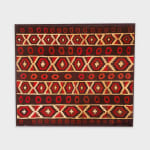Huari Culture 100 AD-1200 AD
Huari Tunic, Circa. 800 AD
Camelid fibres
135 x 117 cm
53'1" x 46 in.
53'1" x 46 in.
HUA0059
Copyright of Paul Hughes Fine Arts
Further images
This brilliantly executed example of bold Huari textile aesthetics exemplifies the culture’s technical virtuosity in expressing abstractly the beliefs that man has the power to create order, transcend space and...
This brilliantly executed example of bold Huari textile aesthetics exemplifies the culture’s technical virtuosity in expressing abstractly the beliefs that man has the power to create order, transcend space and time in a non-representative colourfield of geometrics representing the Andean Cross or Chakana. For, surely accustomed as we are with our late 20th century modes of perception freed from representational conventions, the visual impact of this cloth cannot fail to resonate with the archetypal heritage of abstraction inherent within us all.











